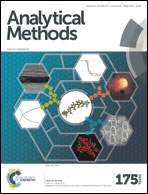Optimization and kinetic studies of photodegradation of Rhodamine B with immobilized Ag-, S-, and N-doped TiO2 under visible irradiation: using Box–Behnken designs (BBDs), multivariate curve resolution (MCR-ALS) and parallel factor (PARAFAC) analysis†
Abstract
This study is based on a two-stage approach. First, an experimental design was used in the optimization for the photodegradation of Rhodamine B dye (RhB) with Ag-, S-, N-doped TiO2, with the concentration of RhB, pH and reaction time as optimization parameters. Second, the degradation rates were estimated through a kinetic study of RhB at the optimal conditions. The kinetic analysis was performed through the measurement of fluorescence excitation–emission matrices (EEMs) coupled with chemometrics. The number of the chemical components involved in the photodegradation process and their concentration and spectra profiles was established by multivariate curve resolution (MCR-ALS) and parallel factor (PARAFAC) analysis.


 Please wait while we load your content...
Please wait while we load your content...